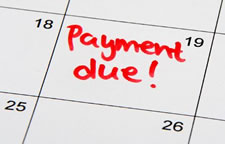By Trent Hamm.
 Recently, my wife and I have been shopping around for a new car.
Recently, my wife and I have been shopping around for a new car.
At one point, we found ourselves at a dealership where we overheard a financial representative talking to another customer.
Part of the representative’s pitch involved looking at different financing options.
The finance person was clearly nudging the customer toward a long-term finance package and was pitching it hard because the package was “only $350 per month”.
Only $350 per month.
At a quick glance, particularly if you’ve never really thought too much about your finances, that might not seem too bad.
If you bring in about $60,000 per year, after taxes, this amounts to about $1,000 per week that’s brought home.
That means the $350 per month is less than 10 per cent of that income.
It doesn’t seem that big in comparison, right?
Wrong.
The idea of a relatively low monthly cost makes it easy to get yourself hooked up to expenses that you really can’t afford over the long run, not because of the individual cost, but because monthly expenses really start to pile up over time.
Let’s say that family signs up for that $350 a month bill for the next six years for that car.
They’ve likely also got a mortgage or rent.
Let’s say that’s $1,500 a month.
They’ve probably got a monthly electric bill.
Let’s park that in at $150 a month.
They’ve all got mobile phones.
That’s another $150 per month.
Maybe they have pay TV.
On average, that’s another $100 per month.
If they’re feeding their family of four, that’s another $500 or so a month.
So, before they even agree to take on this car, out of the $4,000 they’re bringing home, they’ve already locked into place at least $2,400 a month in required expenses that can’t really budge.
That doesn’t include things like minor emergencies, insurance, fuel for their car, car maintenance, home repairs, property taxes, clothing, extra little purchases, and so on, which is covered by the remaining $1,600 a month.
On top of this situation, they want to stack on another $350 per month.
What will that change?
Suddenly, those minor emergencies now have to come out of only $1,250 per month.
They’ve lost about 25 per cent of their monthly breathing room in their budget to afford this car.
There’s another problem, too.
They’re now signed up for a minimum of $2,750 a month in expenses.
What happens if there’s a job loss?
In short, that extra $350 a month is an extra shackle.
Here’s the truth: the pathway to financial success involves avoiding “$X per month” expenses.
You want your monthly required expenses to be as low as humanly possible.
That way, you have enough flexibility in your budget to easily pull yourself out of debt and to start saving for the future.
So, how do you do that?
You drive your car until it’s in need of a number of repairs, and then replace it with what you can afford.
Live in a small place that you can easily afford.
Extract yourself from as many subscription services and monthly bills as possible, or cut their costs as low as possible.
For example, your mobile phone is a monthly bill.
Maybe you can go to a different data plan, or switch carriers.
Your electric bill is a monthly bill.
How can you eat up less energy consistently?
Maybe you can switch to LED lights and leave your thermostat off.
Start using that money you’re saving to pay off debts, starting with your credit cards.
Debts are monthly bills that you can make disappear with some consistent effort.
Credit cards are the worst offenders, as they have a high interest rate, so credit cards are always a good place to start.
Build an emergency fund.
One of the easiest ways to fall right back into debt is to have an unexpected crisis.
A better approach is to have a cash emergency fund — an amount of cash set aside in a savings account for just such purposes.
Once the worst of your debts are gone, start saving for upcoming future expenses.
You’re going to have to eventually replace your car, right?
Start saving for it now.
Don’t let yourself fall into the “it’s only $X per month” trap.
Try to keep that monthly amount you’re required to spend as low as possible, so that you have the flexibility you need to easily handle a job loss or other emergency and to prepare for your future.
It’s also far less stressful.
* Trent Hamm is the founder of The Simple Dollar. He tweets at @trenttsd.
This article first appeared at www.thesimpledollar.com.











